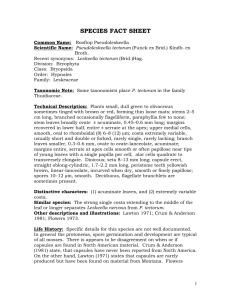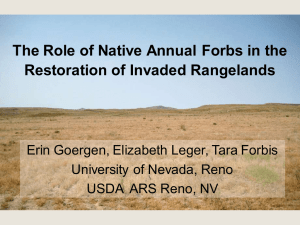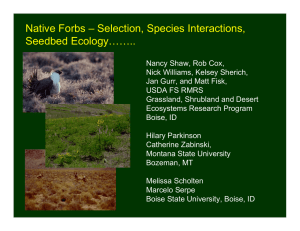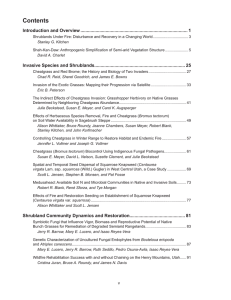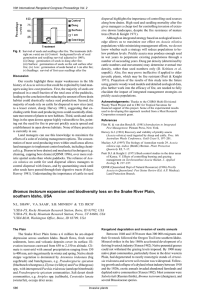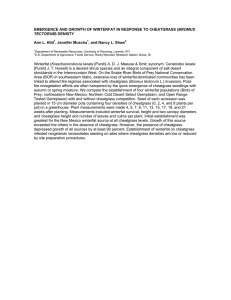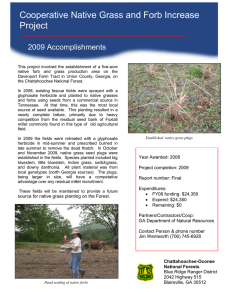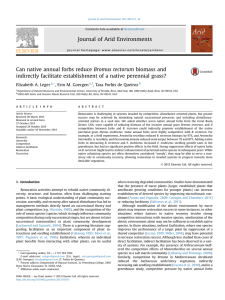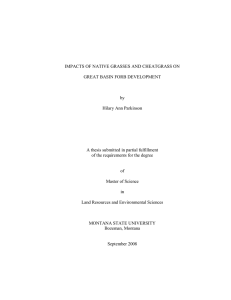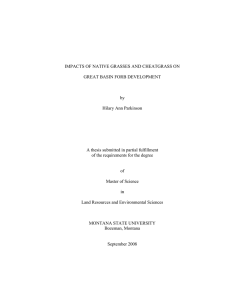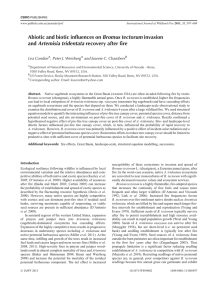Impacts of Cheatgrass and Native Grasses on Great Basin Forb Development Hilary Parkinson
advertisement
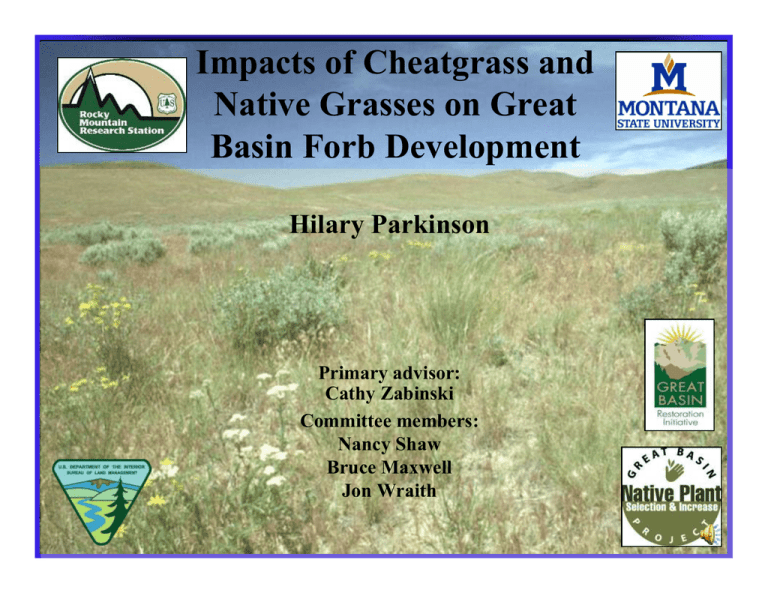
Impacts of Cheatgrass and Native Grasses on Great Basin Forb Development Hilary Parkinson Primary advisor: Cathy Zabinski Committee members: Nancy Shaw Bruce Maxwell Jon Wraith Research Objectives 1. Measure forb response to increasing densities of B. tectorum. 2. Measure forb response to two native grasses compared to B. tectorum. 3. Gather information on the autecology of 5 native forbs (biomass, phenology, RGR, root mass ratios). Field Experiment • Measure the effect of B. tectorum on: 1. Seedling survival 2. Biomass • • Differences among forbs? Measure soil water content with increasing densities of B. tectorum Forbs-Field experiment • Achillea millefolium (yarrow) • Lomatium grayi (Grays biscuitroot) • Eriogonum umbellatum (sulfur flower buckwheat) • Penstemon speciosus (royal penstemon) Experimental Design • 5 B. tectorum seeding densities • 4 forb species • 3 complete blocks • Water content measured in plots seeded at 0, 180 and 360 plants m-2 • 2 locations in Snake River Plain: Lucky Peak and Orchard Impact of Cheatgrass on forb seedling survival • • • • Lucky Peak By May 15, no A. millefolium plants alive in plots seeded with densities of 360 plants m-2 No effect on E. umbellatum Senescence of L. grayi occurred 5 weeks earlier at the highest density of B. tectorum Inadequate sample size for P. speciosus Impact of Cheatgrass on forb biomass Shoot biomass (g) Lucky Peak L. grayi 0.04 A 0.03 E. umbellatum 7 B 5 4 3 P. speciosus A. millefolium 25 BC 20 C 15 0.02 2 3 0.01 1 5 0 0 1 0.00 0 100 200 300 0 10 100 200 300 0 100 200 300 -2 B. tectorum plants m 0 100 200 300 -3 0.35 -3 Soil water content (m /m ) Soil Water Content--20 cm depth with 0, 150-300 and >300 B. tectorum plants m-2 0.30 April 13 0.25 0.20 0.15 0.10 0.05 3/1/07 4/1/07 5/1/07 6/1/0 LOGR ERUM ACMI PESP Relative emergence dates Forbs only -2 150-300 B. tectorum m -2 >300 B. tectorum m May 15-B. tectorum fully mature, harvested Why differences among forbs in response to B. tectorum? Traits shared by forbs that responded better… • Small biomass • Early phenology • Contrasting root morphologies Taprooted/vertically oriented • Eriogonum • Lomatium E. umbellatum & Lomatium Fibrous, laterallybranched • Achillea • Penstemon P. speciosus (& A. millefolium) Reduced biomass and RGR of all forbs No effect E. umbellatum 20% reductions in RGR P. speciosus Elymus B. tectorum elymoides Machaeranther a canescens Sphaelace a Conclusions – B. tectorum reduced survival of only one forb, but only at the highest seeding level-360 B. tectorum plants m-2 – Some native species can germinate and grow well at low densities of B. tectorum – Timing of B. tectorum water use and forb growth may have favored species with early phenology – Root morphology may be an important characteristic to select species that grow well with grasses Additional information Parkinson, H. Zabinski, C. Shaw, N. 2009. Effects of native grasses and cheatgrass on the growth of five Great Basin forbs. Boise (ID): USDA Forest Service Rocky Mountain Research Station. General Technical Report, publication number pending. Parkinson, H. Zabinski, C. Shaw, N. 2009. Growth characteristics of six forbs selected for restoration in the Great Basin. Boise (ID): USDA Forest Service Rocky Mountain Research Station. General Technical Report, publication number pending. Parkinson, H. Zabinski, C. Shaw, N. 2009. The response of four Great Basin forbs to increasing densities of cheatgrass. Boise (ID): USDA Forest Service Rocky Mountain Research Station. General Technical Report, publication number pending. Thanks to Nancy Shaw and all the crew at the Rocky Mountain Research Station.
